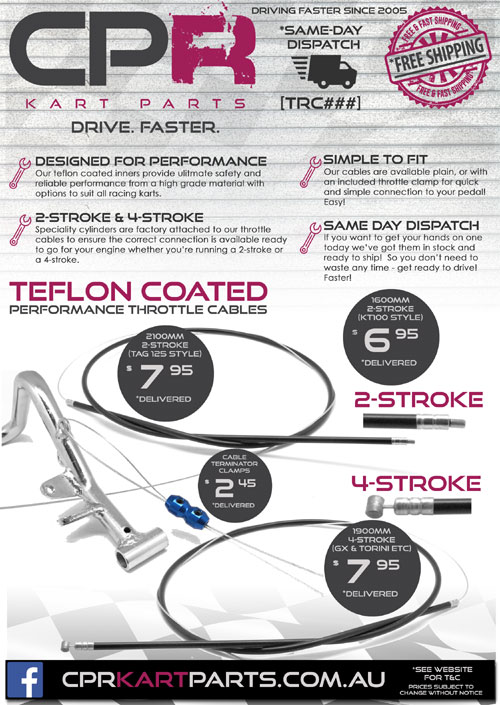: 0425 899 222
: ABN 61 163 730 130 Bank Details - Westpac: Cut Price Racing - BSB 034080 ACC 451877
Home
::
GUIDE - Throttle Cable Selection
GUIDE - Throttle Cable Selection
GUIDE - Throttle Cable Selection
THROTTLE CABLES - THE DEFINITIVE GUIDE TO SELECTING THE CORRECT ONE FOR YOUR RACE KART
Ever wondered what all the different throttle cables listed on our site are about? Why are there so many? Which one is right for my engine? How do I fit it?
If any of these questions spring to mind when looking to replace your existing cable, or looking to fit an entirely new system keep reading - this guide is for you!
HOW IS A THROTTLE CABLE CONSTRUCTED?
Throttle cables are made from two separate parts - the inner twisted cable (which is commonly lined with Teflon) and the outer sheath (usually a composite rubber or nylon with a spiral metal re-enforcement, a nylon liner and metal end-caps). The inner is designed to slide smoothly through the outer sheath.
.jpg)
The inner section usually has a brazed or soldered cylinder attached - designed to interface with either a carburettor fitting, or used as a 'stopper' which assists with locking the end of the inner against a swivel, latch, or receptacle of some type. CPR Carry two different cylinder types. We'll come back to this later in the guide, and explain which cylinder is right for you.
.jpg)
.jpg)
HOW DOES IT CONNECT TO THE PEDAL?
The other end of the inner cable does not have a cylinder, and is designed to be wrapped around a loop and then terminated with a special clamp. Genuine CPR throttle cables are offered with and without a barrel clamp for your convenience. Here is what a terminated throttle cable looks like when attached to a standard race kart pedal:
.jpg)
WHAT HOLDS THE SHEATH IN PLACE ON MY RACE KART?
When fitted to the kart, the sheath must be retained using throttle cable seats. These hold the end caps in position while still allowing the inner to move freely. These are available in different sizes - CPR carry seats to fit 6mm holes or 8mm holes in chassis - you can find them here:
.jpg)
.jpg)
HOW DO I FIGURE OUT WHAT LENGTH I NEED?
The distance between the seats on your kart will correspond with the length of the outer sheath. The inner should be approximately 150-200mm longer than the required length so that it can be adequately wrapped around a pedal ring on one end, and retained on the carburettor or carburettor throttle lever on the other end. All CPR cables are measured primarily from the inner, with the sheath length being available inside the ad along with pictures of the cylinder design.
It is best to select a length that is the same or longer than the distance from your throttle cable lever, to the pedal plus an additional 200mm.
Don't worry if the sheath is longer than the length required, it is fairly easy to shorten the sheath by removing the end cap. This is done by patiently winding the end cap anti-clockwise until it comes off the end. Note that the end cap is press-fit so if it is too tight to wind off, you may need to cut the sheath, remove some material and then wind the rest out. The inner can simply be snipped to length.
.jpg)
.jpg)
.jpg)
HOW DOES IT CONNECT TO THE CARBURETTOR?
Back in the section covering construction, it was noted that there were 2 main different types of cylinders available on our CPR throttle cables, designed for the purpose of covering most 4-stroke and 2-stroke fitment designs. The correct one for you may be both, or one of the two depending on the design of the connection on your carburettor.
For most 4-stroke applications, the TRC402 (CLICK HERE TO VIEW THIS MODEL) with the larger cylinder will likely be the best one for your engine. Engines like the Tornini Clubmaxx have a receptacle that uses this type of cylinder and many other 4-stroke engines have similar receptacles on their levers and butterfly interfaces.
.jpg)
.jpg)
Some engines, including a lot of performance modified 4-stroke engines, utilise a clevis/screw clamp style rotating or non-rotating fitting on the lever, designed for the inner to insert through a hole which is then clamped with a screw. For this type of fitting either of the two different cable cylinders can be used as they are both irrelevant to the connection on the engine end of the cable.
.jpg)
For the majority of 2-Stroke karts (Such as Yamaha KT100's, Rotax 125 Max and other similar TAG engines) - as well as 4-Stroke engines with slide carburettors, the smaller cylinder (5mm long x 3mm diameter) is correct for the fitting on the carburettor. Your carburettor will generally have a receptacle to fit the smaller cylinder either on the lever, or inside the barrell of the slide carburettor. Pictured below is the Yamaha KT100 carburettor fitted with the smaller cylinder receptacle.
.jpg)
.jpg)
WHICH IS THE CORRECT CABLE FOR ME?
Check your receptacle on your carburettor against the cylinders available and choose a compatible cylinder first, then choose a length.
.jpg) For most 4-stroke stationary engines (such as the CPR 10hp ST1 engine or the Torini Clubmaxx) you will usually require the 1.9m cable TRC402 CLICK HERE TO FIND THIS CABLE.
For most 4-stroke stationary engines (such as the CPR 10hp ST1 engine or the Torini Clubmaxx) you will usually require the 1.9m cable TRC402 CLICK HERE TO FIND THIS CABLE..jpg) For most 2-stroke air cooled engines (such as the Yamaha KT100) you will generally need the 1.6m cable TRC202 CLICK HERE TO FIND THIS CABLE.
For most 2-stroke air cooled engines (such as the Yamaha KT100) you will generally need the 1.6m cable TRC202 CLICK HERE TO FIND THIS CABLE..jpg)
For most 2-stroke water-cooled TAG engines (such as Rotax 125 Max and Leopard) you will generally need the 2.0m cable TRC20X CLICK HERE TO FIND THIS CABLE.



